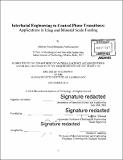Interfacial engineering to control phase transitions : applications in icing and mineral scale fouling
Author(s)
Bengaluru Subramanyam, Srinivas Prasad
DownloadFull printable version (9.975Mb)
Other Contributors
Massachusetts Institute of Technology. Department of Materials Science and Engineering.
Advisor
Kripa K. Varanasi.
Terms of use
Metadata
Show full item recordAbstract
Icing and scale fouling affect the functioning of a number of industries. The problems due to ice accretion have been prevalent for decades in a number of systems including aircrafts, wind turbines and power lines. Similarly, scale formation is one of the major problems that currently plague a number of industries like oil and gas, power plants and desalination systems. The state-of- the-art techniques are either inefficient or expensive making them infeasible in practical applications. The fundamentals of icing and fouling are similar with nucleation, growth and adhesion regimes controlling both the phenomena. Using the tools of surface engineering, I suggest three approaches in this thesis to address these problems - superhydrophobicity, lubricant-impregnation and active electric fields. While micro-textured superhydrophobic surfaces have been shown to be bad for anti-icing due to the formation of frost between the surface textures, I demonstrate low ice adhesion on nano-textured superhydrophobic surfaces because of the stability of vapor pockets even under frost forming conditions. On lubricant-impregnated surfaces, I observe low ice adhesion because of the presence of a liquid lubricant and a high density of crack-initiation sites. I investigated the effect of the surface texture and the properties of the impregnating lubricant on ice adhesion. With respect to scale fouling, I also find more than an order of magnitude decrease in the total amount of scale formed on lubricant-impregnated surfaces due to their extreme smoothness and low surface energy. I have developed a regime map based on the properties of the impregnating lubricant to impart scale-resistance to surfaces. I also utilize the benefits of surface engineering together with an active electric field to introduce defects at the interface of ice and the underlying substrate. Based on the polarity of the substrate, hydrogen or oxygen bubbles evolve during water electrolysis, which are trapped on the surface during freezing. By lowering the ice-substrate interfacial contact area, I observe more than 20 times reduction in ice adhesion using this approach. I establish the importance of understanding the effect of surface polarity, applied voltage and the substrate material on ice adhesion. The approaches suggested here could open up new domains for research in the field of anti-icing and anti-fouling.
Description
Thesis: Ph. D., Massachusetts Institute of Technology, Department of Materials Science and Engineering, 2016. Cataloged from PDF version of thesis. Includes bibliographical references (pages 81-87).
Date issued
2016Department
Massachusetts Institute of Technology. Department of Materials Science and EngineeringPublisher
Massachusetts Institute of Technology
Keywords
Materials Science and Engineering.